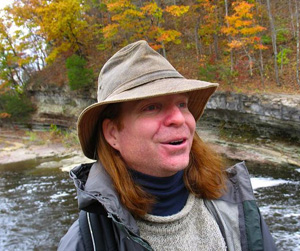
09/21/2012
Although it’s not as exciting as spying the Lake Champlain monster, the discovery of bones from a prehistoric seal in the bed of a former inland sea in the Lake Champlain Valley should intrigue anyone interested in New York state’s natural history.
John Rayburn, a SUNY New Paltz environmental geologist, will share his research findings during a visit to the SUNY Cortland campus on Tuesday, Sept. 25.
Rayburn, a specialist in glacial geology, geomorphology and paleoclimate studies, will discuss “The Champlain Sea: A Record of Marine Conditions in the Lake Champlain Valley” at 7 p.m. in Brockway Hall Jacobus Lounge.
The event continues the Geology Department’s ongoing speaker series that has run for a number of years. The talks are free and open to the public.
While today’s Lake Champlain Valley contains a most impressive long lake, in prehistoric times an inland sea dominated that same region, according to Rayburn.
The marine embayment developed in northern New York around 12,000 years ago at the end of the last Ice Age, Rayburn explained. The weight of the Laurentide Ice Sheet had pressed the entire surface of the earth downwards over the preceding millennia and, as the edge of the ice retreated northwards, salt water was able to flood along the Saint Lawrence Seaway and enter the Champlain Valley.
“The evidence is in the sediments,” Rayburn said. “Marine shells are found in clay deposits throughout the region for this time, and bones of a marine seal also have been found.”
Rayburn has spent the past 14 years documenting the timing and causes of the Champlain Sea event using sediment cores and shoreline deposits. His work has shown the linkage between catastrophic floods from ice-dammed lakes in the Ontario basin and changes in lake and sea levels in the Champlain Valley. These floods reshaped much of the landscape of northern New York and may have influenced circulation of the North Atlantic Ocean and global climate.
David Barclay, a SUNY Cortland associate professor of geology, noted that the College’s own Brauer Education Center in Selkirk, N.Y., is located south of the area flooded by the Champlain Sea.
“However, some of the glacial lakes that were in the Champlain Valley extended south into the Albany and Brauer area, and the catastrophic floods swept all the way down the Hudson Valley and out past what is now New York City,” noted Barclay, who leads geology field trips to the area for his Supplemental Field Studies class.
Rayburn and Barclay are conducting ongoing research in the Champlain Valley using tree rings to model regional climate change.
Rayburn joined SUNY New Paltz’s Geological Sciences Department in 2007 as an assistant professor. He teaches courses within the Geological Sciences and Environmental Geochemical Science programs.
He earned a Ph.D. at Binghamton University, where he was a graduate fellow and teaching assistant. He received an M.Sc. in geology from University of Manitoba. Rayburn completed a bachelor’s degree in geology at SUNY Plattsburgh and another in economics from St. Lawrence University. He completed a research fellowship with the U.S. Department of the Interior’s U.S. Geological Survey in Reston, Va.
Previously, as a Mendenhall Fellow at the United States Geological Survey, Rayburn conducted research on the record and mechanisms of abrupt climate change.
Since 2008, he has edited the New York Glaciogram, an informal newsletter of shared geology information in New York state. He is a co-principal investigator of a study that involves undergraduate student researchers titled “A Comprehensive Approach to Watershed Characterization Focusing on the Source of New York City Water.” The program is funded by the National Science Foundation.
The series is sponsored by the Geology Department, the Geology Club, Campus Artists and Lecture Series and the student activity fee.
For more information, contact Barclay at (607) 753-2921.